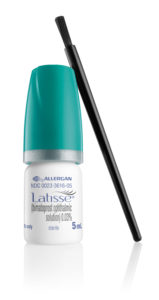Latisse
Latisse
 Eyelashes thin as we age. Latisse can more than double your lash fullness in 16 weeks, making eyelashes longer, thicker and darker.
Eyelashes thin as we age. Latisse can more than double your lash fullness in 16 weeks, making eyelashes longer, thicker and darker.
Latisse works gradually. You’ll start to see longer lashes after four weeks and fuller, darker lashes after eight weeks with the most dramatic results seen after 16 weeks.
To learn more, visit Latisse.com. To purchase Latisse, visit the Medical Skin Care Center, send us a message or call 763-684-3700.
| Latisse (5 ml) | $189.99 |
Before & After: Patient Progression


LATISSE® (bimatoprost ophthalmic solution) 0.03% Important Information
Indication
LATISSE® (bimatoprost ophthalmic solution) 0.03% is indicated to treat hypotrichosis of the eyelashes by increasing their growth, including length, thickness, and darkness.
Important Safety Information
Contraindications: LATISSE® is contraindicated in patients with hypersensitivity to bimatoprost or to any of the ingredients.
Warnings and Precautions: In patients using LUMIGAN® (bimatoprost ophthalmic solution) or other prostaglandin analogs for the treatment of elevated intraocular pressure (IOP), the concomitant use of LATISSE® may interfere with the desired reduction in IOP. Patients using prostaglandin analogs including LUMIGAN® for IOP reduction should only use LATISSE® after consulting with their physician and should be monitored for changes to their intraocular pressure.
Increased iris pigmentation has occurred when bimatoprost solution was administered. Patients should be advised about the potential for increased brown iris pigmentation, which is likely to be permanent.
Bimatoprost has been reported to cause pigment changes (darkening) to periorbital pigmented tissues and eyelashes. The pigmentation is expected to increase as long as bimatoprost is administered, but has been reported to be reversible upon discontinuation of bimatoprost in most patients.
There is the potential for hair growth to occur in areas where LATISSE® solution comes in repeated contact with skin surfaces. Apply LATISSE® only to the skin of the upper eyelid margin at the base of the eyelashes.
LATISSE® solution should be used with caution in patients with active intraocular inflammation (eg, uveitis) because the inflammation may be exacerbated. LATISSE® should be used with caution in aphakic patients, in pseudophakic patients with a torn posterior lens capsule, or in patients with known risk factors for macular edema.
Adverse Reactions: The most frequently reported adverse events were eye pruritus, conjunctival hyperemia, skin hyperpigmentation, ocular irritation, dry eye symptoms, and periorbital erythema. These reactions occurred in less than 4% of patients.
Postmarketing Experience: The following adverse reactions have been identified during postapproval use of LATISSE®: dry skin of the eyelid and/or periocular area, eye swelling, eyelid edema, hordeolum, hypersensitivity (local allergic reactions), lacrimation increased, madarosis and trichorrhexis (temporary loss of a few eyelashes to loss of sections of eyelashes, and temporary eyelash breakage, respectively), periorbital and lid changes associated with a deepening of the eyelid sulcus, rash (including macular and erythematous), skin discoloration (periorbital), trichiasis, and vision blurred
Please see LATISSE® full Prescribing Information.


